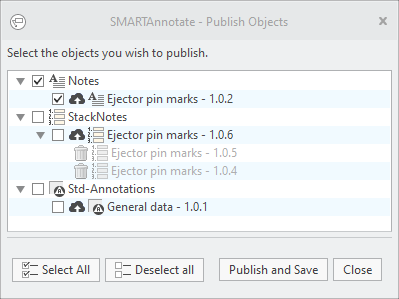Revising objects
SMARTAnnotate offers a sophisticated revising functionality that is designed to
- Restore drawing or model content to any time in the past for translation purpose
- Notify the user about changes in texts and / or in the configuration
- Distinguish between published revisions for final usage and temporary revisions for administrative purposes.
Revising texts and object definitions
- Use the Object Edit or Text Edit dialog to modify any of the relevant objects or texts.
- Leaving the Edit dialog with OK, a new Revision will be created and indicated as ‘unpublished’ automatically.
- You can verify the revision increase and the change to ‘unpublished’ when you open the object definition again.
- Modified objects will be also marked as Unpublished in the object list.
- To discard all unsaved modifications use Exit from the Admin dialog.
Saving modifications
Saving objects or texts stores the data in the respective .xml files.
- Click Save to store your modified objects within Admin mode.
- All new revisions of modified objects will be stored in the respective .xml files within the configuration, but not marked as published for user mode. That applies to texts and SMARTAnnotate objects definitions.
- If running SMARTAnnotate Admin mode, you will see the changes and may verify your modifications.
- In user mode you will not see these changes.
- You still can delete object definitions from the configuration that never have been published.
- All text revisions are kept in the configuration and can only be deleted, if they are not used in any revision of a SMARTAnnotate object definition.
- All new revisions of modified objects will be stored in the respective .xml files within the configuration, but not marked as published for user mode. That applies to texts and SMARTAnnotate objects definitions.
Publishing object definitions for user visibility
The publishing mechanism is designed to keep your configuration clean and tidy. It is relevant for objects definitions only
except for Parameters and Parameter Sets .

- Click
 Publish to mark modified or new object definitions for the usage in User mode
Publish to mark modified or new object definitions for the usage in User mode
- The Publish dialog opens and shows a list of all unpublished object definitions.

- Select those definitions that you want to publish.
- Click Publish and Save
- The selected object definitions will be marked as ‘published’ and saved. They cannot be deleted from the configuration anymore. You can set these definitions to ‘Obsolete’ instead.
- All ‘unpublished’ revisions of the selected object definitions, that you may have saved in the meantime, will be deleted from the .xml files.
- You will see the published revisions of the object definition in user and admin mode.
- The Publish dialog opens and shows a list of all unpublished object definitions.
Relevance for revising and exceptions
In general all objects and its internal entities are relevant for revising. Nevertheless there are some exceptions as these
objects have no or irrelevant impact on how a drawing or model may looks like or has looked like in the past.
Excepted objects are:
- Parameter
- Parameter Sets
Within all object definitions there are some entities that also do not have an impact on the content of the drawing or model.
If you modify these attributes, no revision will be created.
Excepted attributes are indicated in the Object Edit dialog with an unfilled circle  . Examples are:
. Examples are:
- UI label and UI description
- Admin label
- Hyperlink
- Position index
Workflow to manually restore a legacy drawing or model for translation purpose
- Open the legacy drawing or model
- Open SMARTAnnotate dialog and switch the language
- The language is switched to the new settings and reflects the respective texts and layouts.
- In case a legacy object or text revision of an entry is missing the user will get the following information that he may send
to the administrator for attention and repair.
Automatic translation process
- The worker opens a released legacy drawing or model
- SMARTAnnotate is opened and the language switched to the intended setting.
- The worker exports a 2D-PDF file
- In case a requested revision of a text or object definition a log-file is written to the pre-defined folder location.
You can use the config options missing_revisions_output_path and missing_revisions_placeholde_text to tweak the log-file
- In case a requested revision of a text or object definition a log-file is written to the pre-defined folder location.
User notification
- Whenever a user opens a drawing or models and activates the SMARTAnnotate dialog, he will be notified on changed objects and texts that are used in his Creo drawing or model.
- He may use the Notification Center to update or repair the issues. More details on this you can find in the User guide.